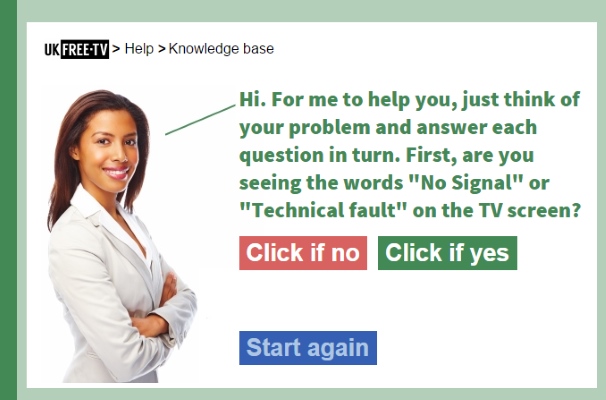Use the Knowledge base to find answers to your technical problems

I'm pleased to announce a new service for UK Free TV: the Knowledge Base.
This service has replaced the all "Diagnostics" section. There was a problem with the logic with the old service that didn't allow new help to be added to the original data.
The new service can very easily be extended to include new issues and problems as they arise. The current design maps the most popular questions to have easily reached answers. It also takes you directly to the page with the answer on it, cutting the number of clicks required.
I have left the old Diagnostics pages up - with the content grayed out and crossed out - as there are many useful comments on those pages. I will, eventually, migrate these to the new system.
As ever, please let me know what you think can be added.
With the technology for 4K TV broadcasts developing and the ever increasing demand for radio spectrum by the mobile phone industry, I was wondering whether it may be possible to develop hybrid terrestrial/IPTV transmissions, where the terrestrial transmission provides a standard 1080p HD channel that can be optionally synchronized with an IPTV feed to take it up to 4K. Would it be possible to do something like this, either using DVB-T2 as a base or a completely new transmission standard?
| link to this comment |
Charles's: mapC's Freeview map terrainC's terrain plot wavesC's frequency data C's Freeview Detailed Coverage
12:23 AM
Charles Stuart: I wouldn't have thought it was worth the trouble of trying to reduce the internet bandwidth slightly by making simultaneous reception on DVB-T2 a requirement for 4K IP-TV.
| link to this comment |
Charles Stuart: With each version of mobile technology, there has been a form of "broadcast" or "multicast" service within the specification, such as MBMS Multimedia Broadcast Multicast Service - Wikipedia, the free encyclopedia as demonstated by Nokia Networks here Nokia Networks first to trial LTE for national TV broadcasting | Nokia Networks
However, there are a number of reasons people in the industry don't think this will work:
1) The spectrum efficiency of DVB-T2 is very high, so MBMS might work, but it can't bring any more bits to the party.
2) Mobile networks are based around "cell towers" that have a higher density than the DVB-T networks. For adoption this would mean that 95% of TVs aerial would need to be changed and the broadcasters would have to move from their large tower network to a cell network.
3) The industry understands DVB-T/T2 as it was built on the ages-old UHF analogue network, moving to a new format would mean massive re-education.
4) If you want higher bitrates for TV, then fibre-optic is the way to go. For example, I have 1,000 Megabits per second here for £20 a month. https://www.hyperoptic.co…me#2 and it's a mature technology.
5) DVB-T is a mature technology, adding it to TV sets is almost cost-free, and DVB-T2 low cost. MBMS has no installed base so the costs of any set-top boxes would be high as the R&D budget would need to be paid for.
| link to this comment |
9:56 PM
Trowbridge
Further to what Briantist and Brian Gregory have said, there is a major problem with synchronisation of content delivered via different media. In all distribution systems there are delays due to the physics of the communication methods used. Even the old fashioned postal service has delays, as does delivery via courier but a letter normally arrives quicker if sent via RM than via Courier. So with TV distribution, delivery via an RF transmitter standing on the ground has natural delays due to atmospheric propogation, distribution via a control centre, microwave links, etc. Those delays are generall slightly shorter when compared to a satellite system. That has an inherent delay as the signal has further to travel (up to the satellite, through its electronic systems and retransmitted for reception on the ground again). Those delays are typicall around 4 seconds, using the Atra satellites as an example, and almost all that delay is in the uplink and downlink path.
The internet has its own inherent delays due to propogation either along a copper wire or through a fibre optic connection. Then there are delays in the servers that control and distribute the data streams like On Demand TV. Those delays vary from quite short, maybe around 2 seconds on a good service to well over 20 seconds in some cases.
Try an experiment with your internet service and an AM or FM radio. Set both to deliver BBC Radio 4 at 6 PM and listen for the 'pips'. You will find that the FM and AM are almost together, but the internet has a noticeable delay. Ypou can add the satellite version of Radio 4 and see how much greater the delay can be over FM. DAB also has a longer delay than FM or AM. It's all due to physics of communication.
So now imaging trying to synchronise TV pictures delivered by two different methods. With differeing delays that are actually quite variable and somewhat unpredictable, there would be a mind blowingly difficult problem of how to 'dovetail' all the data together to make a single coherent picture without strange and disturbing visual artefacts!
| link to this comment |
MikeP's: mapM's Freeview map terrainM's terrain plot wavesM's frequency data M's Freeview Detailed Coverage
MikeP, I understand your point but wouldn't it be possible to store the faster transmission until the slower transmission arrived and then combine them? I mean this as a standalone question, regardless of whether or not my original idea is feasible.
On a separate subject, just how many channels have they got onto COM7? I seem to make it 6 full-time equivalent HD channels plus two SD channels. If that's right, could the BBC add Red Button services and maybe another channel or two to PSB3?
| link to this comment |
Charles's: mapC's Freeview map terrainC's terrain plot wavesC's frequency data C's Freeview Detailed Coverage
MikeP: re "Try an experiment with your internet service and an AM or FM radio. Set both to deliver BBC Radio 4 at 6 PM and listen for the 'pips'. You will find that the FM and AM are almost together, but the internet has a noticeable delay."
From what I recall, the delay had little to do with the internet. It comes from the encoding being done on a satellite feed!
Online the buffering delay is a function of the buffer size required by the receiver software and radios couple of hundred kilobits per second is tiny compared to a standard broadband.
For efficient video coding a large frame buffer is needed but both the encode and receiver need a defined smelling of RAM.
Quite why DAB radios have different buffer sizes is a mystery...
| link to this comment |
9:16 PM
Trowbridge
Briantist:
Before I wrote that I did the test myself. My AM and FM radios differ by so little it is hard to discern. The DAB radio I have, a not expensive one, had a delay of about .3 seconds, noticably more than the AM & FM services but less than the Internet. My Internet was about 0.6 seconds delayed but that varies by about 0.2 seconds over time. The Sky satellite signals have a delay of approximately 4 seconds almost entirely due to the propagation time needed to cover the 80,000 km for the up and down links. The internet signals are digitally encoded, as are the satellite signals, so I suspect there will be little difference in the delays introduced during encoding and decoding.
The real point was that trying to 'interleave' the signals delivered via different transmission media may well prove the stumbling block to the idea of having HD via DVB-T (or DVB-T2) or satellite and then adding in the extra data needed for 4k that is delivered via a totally different route with different, and non-static, delays. As an electronics engineer, I cannpot see a way of overcoming the variability of the delays that are inherently different. If we could, it's an idea worthy of investigation.
| link to this comment |
MikeP's: mapM's Freeview map terrainM's terrain plot wavesM's frequency data M's Freeview Detailed Coverage
10:09 PM
Trowbridge
Charles Stuart
To do that would require every frame to be uniquely identifiable so that matching HD frames can be paired with their 4k counterparts. As the system currently used does not have that unique identifaction ability there is no way to combine them without serious visual artifacts that would be even more disturbing that the pixilation we already see.
The ability to store numerous frames is not so much of a problem these days, memory is relatively cheap for large amounts (that is for RAM memory and not hard disk type) and the electronics needed to control it all should not be an insurmountable problem, it's the lack of ID per frame that is the 'stumbling block' currently.
Some years ago, the firm I worked for wanted to make a 'video wall' before they became commercially available. The main problems we found were that digitisation was far too slow in those days (1980s) and data storage was not only slow by extremely expensive! We even discussed the ideas with both BBC and Central TV (I worked in the East Midlands) and they were interested in the ideas as they were trying to develop the same for theiur studios - but they were finding the same problems. Modern electronics has overcome the speed and cost so we now have video walls all around. But they have not solved the interleaving problem yet either.
| link to this comment |
MikeP's: mapM's Freeview map terrainM's terrain plot wavesM's frequency data M's Freeview Detailed Coverage

